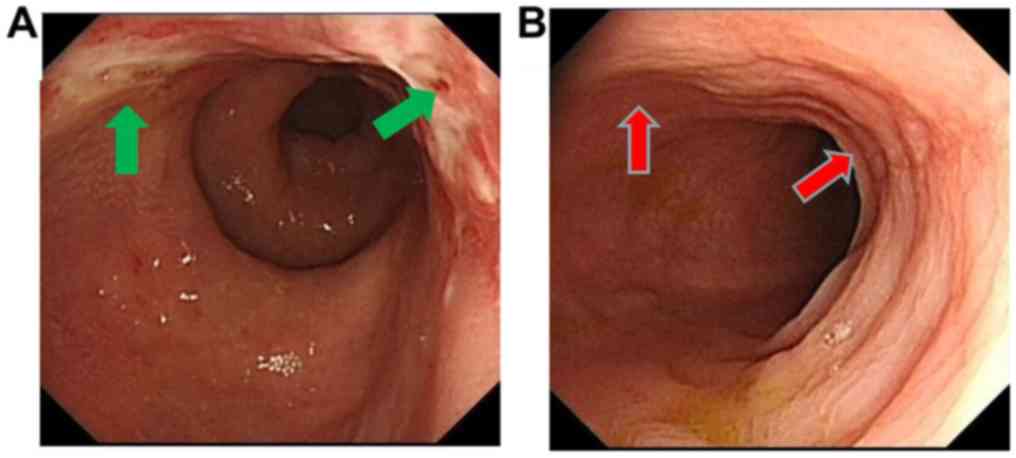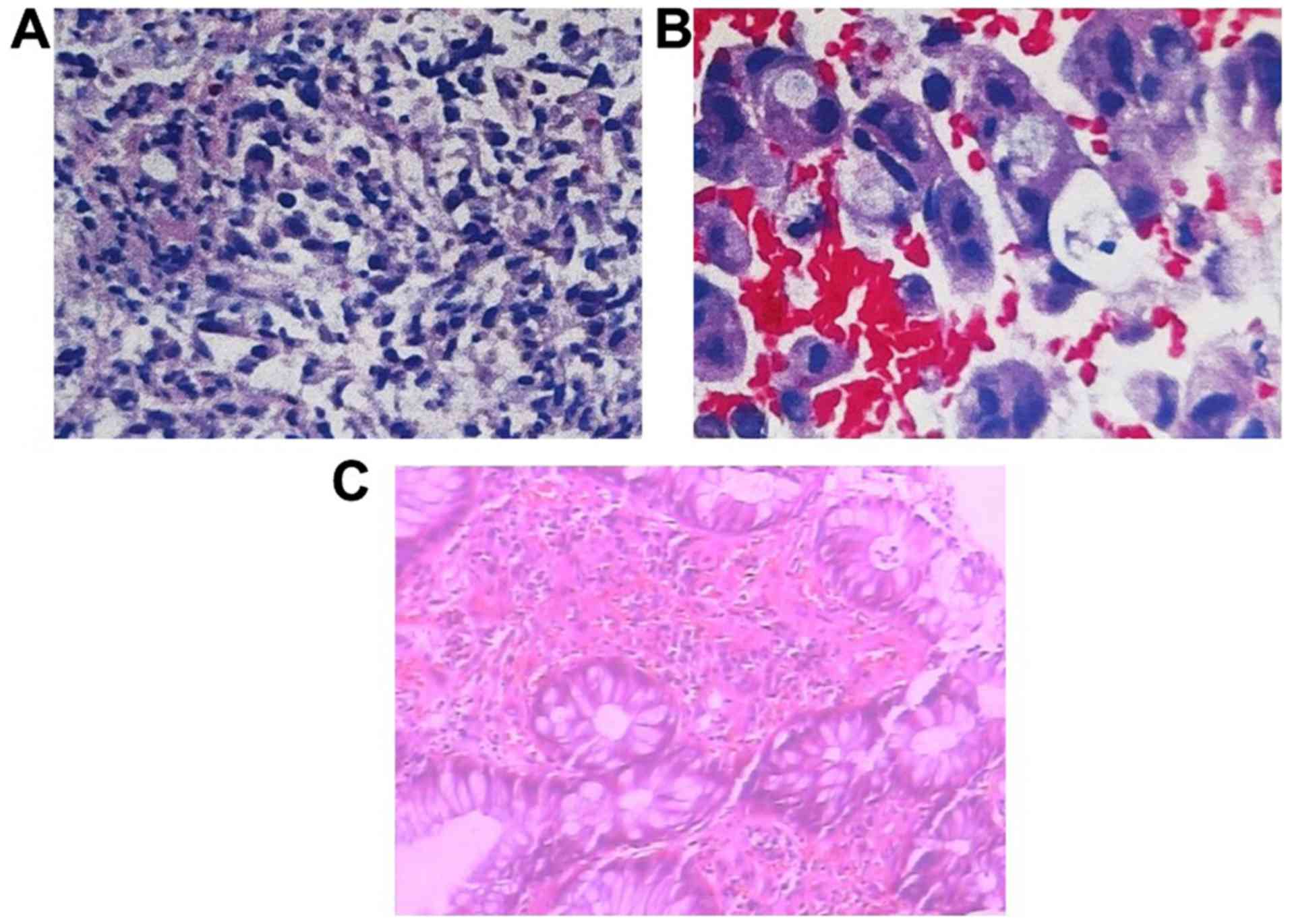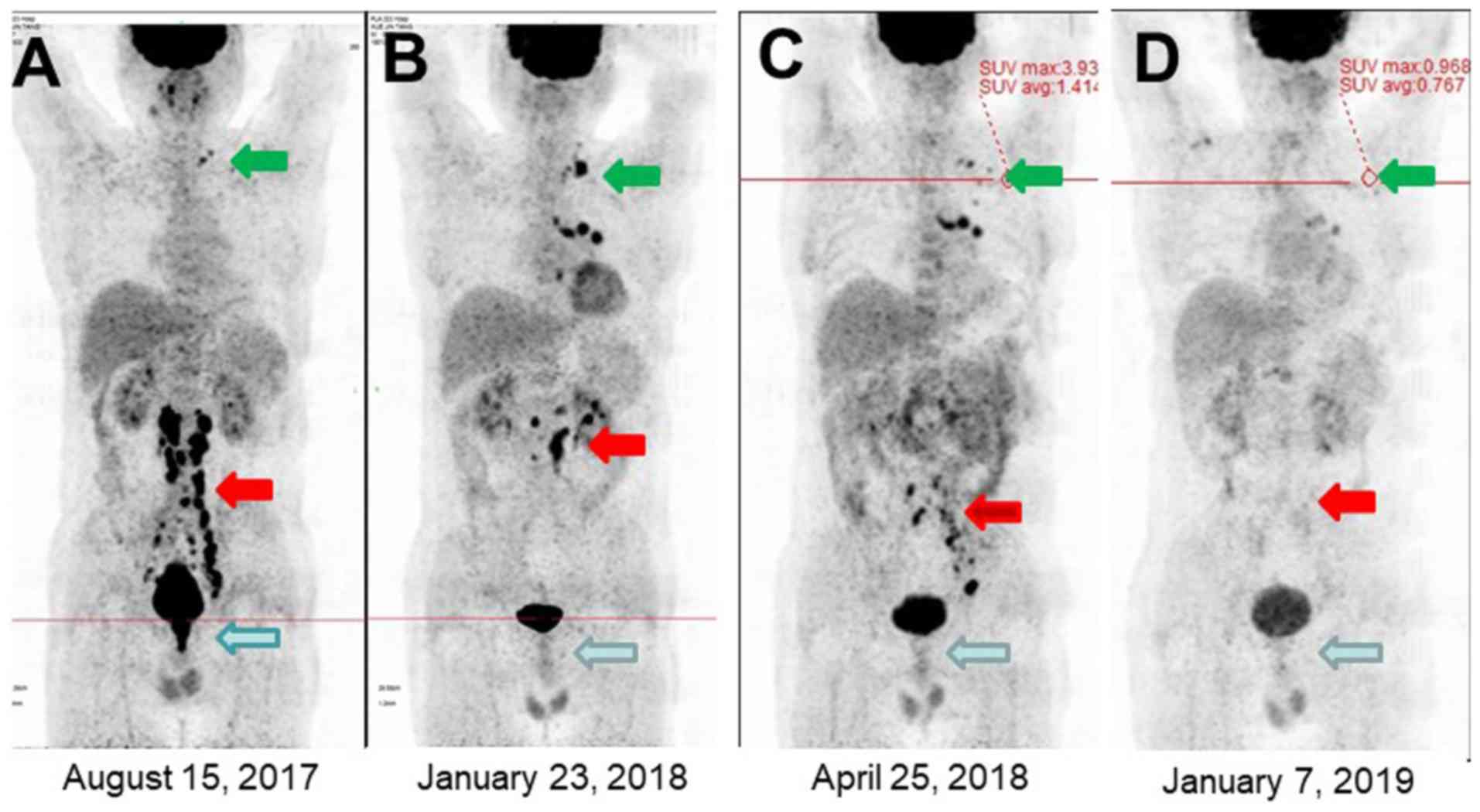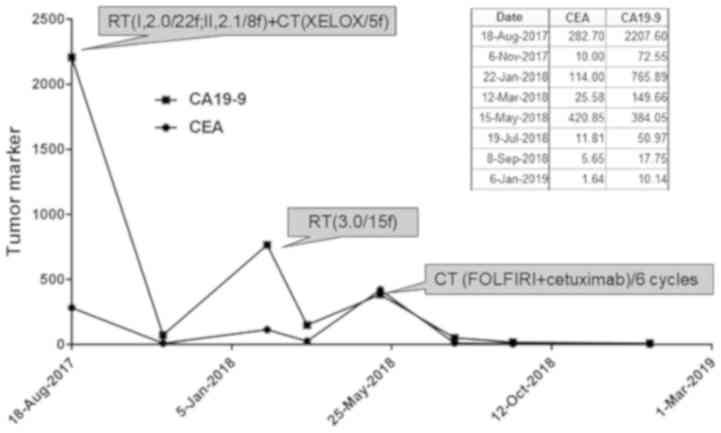|
1
|
Siegel R, Desantis C and Jemal A:
Colorectal cancer statistics, 2014. CA Cancer J Clin. 64:104–117.
2014.PubMed/NCBI View Article : Google Scholar
|
|
2
|
Isbister WH: Audit of definitive colorectal
surgery in patients with early and advanced colorectal cancer. ANZ
J Surg. 72:271–274. 2002.PubMed/NCBI
|
|
3
|
Lee WS, Yun SH, Chun HK, Lee WY, Yun HR,
Kim J, Kim K and Shim YM: Pulmonary resection for metastases from
colorectal cancer: Prognostic factors and survival. Int J
Colorectal Dis. 22:699–704. 2007.PubMed/NCBI View Article : Google Scholar
|
|
4
|
Yoo PS, Lopez-Soler RI, Longo WE and Cha
CH: Liver resection for metastatic colorectal cancer in the age of
neoadjuvant chemotherapy and bevacizumab. Clin Colorectal Cancer.
6:202–207. 2006.PubMed/NCBI View Article : Google Scholar
|
|
5
|
Bernier L, Balyasnikova S, Tait D and
Brown G: Watch-and-wait as a therapeutic strategy in rectal cancer.
Curr Colorectal Cancer Rep. 14:37–55. 2018.PubMed/NCBI View Article : Google Scholar
|
|
6
|
Yahya J, Herzig D, Farrell M, Degnin C,
Chen Y, Holland J, Brown S, Binder C, Jaboin J, Tsikitis VL, et al:
Survey results of US radiation oncology providers' contextual
engagement of watch-and-wait beliefs after a complete clinical
response to chemoradiation in patients with local rectal cancer. J
Gastrointest Oncol. 9:1127–1132. 2018.PubMed/NCBI View Article : Google Scholar
|
|
7
|
Habr-Gama A, Perez RO, Nadalin W, Sabbaga
J, Ribeiro U Jr, Silva e Sousa AH Jr, Campos FG, Kiss DR and
Gama-Rodrigues J: Operative versus nonoperative treatment for stage
0 distal rectal cancer following chemoradiation therapy: Long-term
results. Ann Surg. 240:711–717. 2004.PubMed/NCBI View Article : Google Scholar
|
|
8
|
Mayer RJ, Van Cutsem E, Falcone A, Yoshino
T, Garcia-Carbonero R, Mizunuma N, Yamazaki K, Shimada Y, Tabernero
J, Komatsu Y, et al: Randomized trial of TAS-102 for refractory
metastatic colorectal cancer. N Engl J Med. 372:1909–1919.
2015.PubMed/NCBI View Article : Google Scholar
|
|
9
|
Faron M, Pignon JP, Malka D, Bourredjem A,
Douillard JY, Adenis A, Elias D, Bouché O and Ducreux M: Is primary
tumor resection associated with survival improvement in patients
with colorectal cancer and unresectable synchronous metastases? A
pooled analysis of individual data from four randomized trials. Eur
J Cancer. 51:166–176. 2015.PubMed/NCBI View Article : Google Scholar
|
|
10
|
Cirocchi R, Trastulli S, Abraha I,
Vettoretto N, Boselli C, Montedori A, Parisi A, Noya G and Platell
C: Non-resection versus resection for an asymptomatic primary tumor
in patients with unresectable stage IV colorectal cancer. Cochrane
Database Syst Rev. 8(CD008997)2012.PubMed/NCBI View Article : Google Scholar
|
|
11
|
McCahill LE, Yothers G, Sharif S, Petrelli
NJ, Lai LL, Bechar N, Giguere JK, Dakhil SR, Fehrenbacher L, Lopa
SH, et al: Primary mFOLFOX6 plus bevacizumab without resection of
the primary tumor for patients presenting with surgically
unresectable metastatic colon cancer and an intact asymptomatic
colon cancer: Definitive analysis of NSABP trial C-10. J Clin
Oncol. 30:3223–3228. 2012.PubMed/NCBI View Article : Google Scholar
|
|
12
|
Temple LK, Hsieh L, Wong WD, Saltz L and
Schrag D: Use of surgery among elderly patients with stage IV
colorectal cancer. J Clin Oncol. 22:3475–3484. 2004.PubMed/NCBI View Article : Google Scholar
|
|
13
|
Poultsides GA, Servais EL, Saltz LB, Patil
S, Kemeny NE, Guillem JG, Weiser M, Temple LK, Wong WD and Paty PB:
Outcome of primary tumor in patients with synchronous stage IV
colorectal cancer receiving combination chemotherapy without
surgery as initial treatment. J Clin Oncol. 27:3379–3384.
2009.PubMed/NCBI View Article : Google Scholar
|
|
14
|
Huang S, Dang Y, Li F, Wei W, Ma Y, Qiao S
and Wang Q: Biological intensity-modulated radiotherapy plus
neoadjuvant chemotherapy for multiple peritoneal metastases of
ovarian cancer: A case report. Oncol Lett. 9:1239–1243.
2015.PubMed/NCBI View Article : Google Scholar
|
|
15
|
Glynne-Jones R and Hughes R: Critical
appraisal of the ‘wait and see’ approach in rectal cancer for
clinical complete responders after chemoradiation. Br J Surg.
99:897–909. 2012.PubMed/NCBI View
Article : Google Scholar
|
|
16
|
Park IJ, You YN, Agarwal A, Skibber JM,
Rodriguez-Bigas MA, Eng C, Feig BW, Das P, Krishnan S, Crane CH, et
al: Neoadjuvant treatment response as an early response indicator
for patients with rectal cancer. J Clin Oncol. 30:1770–1776.
2012.PubMed/NCBI View Article : Google Scholar
|
|
17
|
Appelt AL, Pløen J, Harling H, Jensen FS,
Jensen LH, Jørgensen JC, Lindebjerg J, Rafaelsen SR and Jakobsen A:
High-dose chemoradiotherapy and watchful waiting for distal rectal
cancer: A prospective observational study. Lancet Oncol.
16:919–927. 2015.PubMed/NCBI View Article : Google Scholar
|
|
18
|
Goldberg RM, Sargent DJ, Morton RF, Fuchs
CS, Ramanathan RK, Williamson SK, Findlay BP, Pitot HC and Alberts
SR: A randomized controlled trial of fluorouracil plus leucovorin,
irinotecan, and oxaliplatin combinations in patients with
previously untreated metastatic colorectal cancer. J Clin Oncol.
22:23–30. 2004.
|
|
19
|
Bokemeyer C, Van Cutsem E, Rougier P,
Ciardiello F, Heeger S, Schlichting M, Celik I and Köhne CH:
Addition of cetuximab to chemotherapy as first-line treatment for
KRAS wild-type metastatic colorectal cancer: Pooled analysis of the
CRYSTAL and OPUS randomised clinical trials. Eur J Cancer.
48:1466–1475. 2012.PubMed/NCBI View Article : Google Scholar
|
|
20
|
McCawley N, Clancy C, O'Neill BD, Deasy J,
McNamara DA and Burke JP: Mucinous rectal adenocarcinoma is
associated with a poor response to neoadjuvant chemoradiotherapy: A
systematic review and meta-analysis. Dis Colon Rectum.
59:1200–1208. 2016.PubMed/NCBI View Article : Google Scholar
|
|
21
|
Ren F, Weng W, Zhang Q, Tan C, Xu M, Zhang
M, Wang L, Sheng W, Ni S and Huang D: Clinicopathological features
and prognosis of AFP-producing colorectal cancer: A single-center
analysis of 20 cases. Cancer Manag Res. 11:4557–4567.
2019.PubMed/NCBI View Article : Google Scholar
|
|
22
|
Douillard JY, Oliner KS, Siena S,
Tabernero J, Burkes R, Barugel M, Humblet Y, Bodoky G, Cunningham
D, Jassem J, et al: Panitumumab-FOLFOX4 treatment and RAS mutations
in colorectal cancer. N Engl J Med. 369:1023–1034. 2013.PubMed/NCBI View Article : Google Scholar
|
|
23
|
Perez RO, Habr-Gama A, Gama-Rodrigues J,
Proscurshim I, Julião GP, Lynn P, Ono CR, Campos FG, Silva e Sousa
AH Jr, Imperiale AR, et al: Accuracy of positron emission
tomography/computed tomography and clinical assessment in the
detection of complete rectal tumor regression after neoadjuvant
chemoradiation: Long-term results of a prospective trial (national
clinical trial 00254683). Cancer. 118:3501–3511. 2012.PubMed/NCBI View Article : Google Scholar
|


















